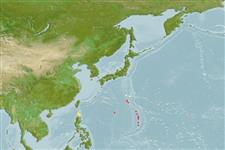>
Acanthuriformes (Surgeonfishes) >
Pomacanthidae (Angelfishes)
Etymology: Centropyge: Greek, kentron = sting + Greek, pyge = tail (Ref. 45335).
Eponymy: John W Shepard worked at the Marine Laboratory, UOG Station, Mangilao, Guam (part of the University of Guam). [...] (Ref. 128868), visit book page.
More on authors: Randall & Yasuda.
Environment: milieu / climate zone / depth range / distribution range
Écologie
marin récifal; non migrateur; profondeur 1 - 56 m (Ref. 1602). Tropical; 28°N - 15°N
Western Pacific: known only from the Mariana and Ogasawara Islands; possibly a population southwest of Palau.
Taille / Poids / Âge
Maturity: Lm ? range ? - ? cm
Max length : 9.0 cm TL mâle / non sexé; (Ref. 9710); common length : 7.0 cm SL mâle / non sexé; (Ref. 37816)
Épines dorsales (Total) : 14; Rayons mous dorsaux (Total) : 16 - 18; Épines anales: 3; Rayons mous anaux: 17 - 18. Its ground color is variable, ranging from almost red to light apricot. The barring can be reduced to a small patch behind the operculum, and in rare cases, be entirely absent. The blue trim on the soft dorsal and anal fins is absent or reduced in females and highly developed in males.
A common species (Ref. 9710) found singly or in small groups in exposed outer reef slopes and occasionally in clear lagoon reefs. Prefers areas of mixed dead and living corals with numerous shelter holes and passages (Ref. 1602). Feeds mainly on benthic algae. Forms harems of 3-7 individuals. Occasionally exported through the aquarium trade (Ref. 48391).
Life cycle and mating behavior
Maturité | Reproduction | Frai | Œufs | Fécondité | Larves
Allen, G.R., 1985. Butterfly and angelfishes of the world. Vol. 2. 3rd edit. in English. Mergus Publishers, Melle, Germany. (Ref. 4858)
Statut dans la liste rouge de l'IUCN (Ref. 130435: Version 2024-2)
Menace pour l'homme
Harmless
Utilisations par l'homme
Pêcheries: commercial; Aquarium: Commercial
Outils
Articles particuliers
Télécharger en XML
Sources Internet
Estimates based on models
Phylogenetic diversity index (Ref.
82804): PD
50 = 0.5000 [Uniqueness, from 0.5 = low to 2.0 = high].
Bayesian length-weight: a=0.03090 (0.01378 - 0.06932), b=2.88 (2.69 - 3.07), in cm total length, based on LWR estimates for this (Sub)family-body shape (Ref.
93245).
Niveau trophique (Ref.
69278): 2.0 ±0.00 se; based on food items.
Résilience (Ref.
120179): Haut, temps minimum de doublement de population inférieur à 15 mois (Preliminary K or Fecundity.).
Fishing Vulnerability (Ref.
59153): Low vulnerability (10 of 100).
Nutrients (Ref.
124155): Calcium = 122 [56, 193] mg/100g; Iron = 0.789 [0.466, 1.392] mg/100g; Protein = 17.8 [16.5, 19.0] %; Omega3 = 0.115 [0.066, 0.194] g/100g; Selenium = 27 [13, 55] μg/100g; VitaminA = 93.3 [21.0, 385.4] μg/100g; Zinc = 2.13 [1.41, 3.26] mg/100g (wet weight);
